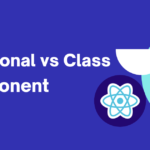React 15.3 introduced PureComponent – a new way of implementing class-based components. It is now available to us alongside function-based components and components derived from React.Component.
This new technique caused much confusion in React rounds. Is PureComponent a new improved version of React.Compoment? Does it automatically make everything better? Should you just slap PureComponent everywhere and enjoy your faster React app?
What is PureComponent
PureComponent is a base class for React class-based components. It implements shouldComponentUpdate lifecycle method like this:
return (
!shallowEqual(oldProps, newProps) ||
!shallowEqual(oldState, newState)
);It checks whether the state or props changed using shallow equality comparison.
If the props and the state hasn’t changed, the component is not re-rendered.
shallowEqualperforms a shallow equality check by iterating on the keys of the objects being compared and returning true when the values of a key in each object are not strictly equal. Source: React documentation
PureComponent is an advanced optimisation technique. Optimisation because it has a potential to make your application faster. Advanced because it can also break your app if you are not careful.
To use PureComponent simply derive your class-based component from React.PureComponent instead of React.Component.
class MyPureComponent extends React.PureComponent {
...
}Why to use PureComponent
Both functional-based and class-based components have the same downside: they always re-render when their parent component re-renders even if the props don’t change.
Also, class-based components always re-render when its state is updated (this.setState is called) even if the new state is equal to the old state.
Moreover, when a parent component re-renders, all of its children are also re-rendered, and their children too, and so on.
That behaviour may mean a lot of wasted re-renderings. Indeed, if our component only depends on its props and state, then it shouldn’t re-render if neither of them changed, no matter what happened to its parent component.
That is precisely what PureComponent does – it stops the vicious re-rendering cycle. PureComponent does not re-render unless its props and state change.
Caveats
1. State and Props immutability
Since the props and state equality is checked via a shallow equality, PureComponent only works if its props and state are immutable. That is, if you pass an object prop into a component derived from React.Purecomponent, you should always create a new prop object on every change instead of modifying its values. The same with a state – always create a new state within this.setState call instead of changing the existing one. If you don’t, then shallow equality won’t be able to detect the change, and your component won’t re-render when it needs to.
This article by Niels Gerritsen explains immutable objects very well
2. shouldComponentUpdate
If you plan to implement your own shouldComponentUpdate in your component, then you can’t use React.PureComponent as a base. If you do, you will get error “shouldComponentUpdate should not be used when extending React.PureComponent. Please extend React.Component if shouldComponentUpdate is used.”
When to use PureComponent
To sum it up, PureComponent is useful when:
- You want to avoid re-rendering cycles of your component when its props and state are not changed, and
- The state and props of your component are immutable, and
- You don’t plan to implement your own
shouldComponentUpdatelifecycle method.
On the other hand, you should not use PureComponent as a base for you component if:
- Your props or state are not immutable, or
- You plan to implement your own
shouldComponentUpdatelifecycle method.
Thank you for reading.





 What is the difference between functional and class-based React components?
What is the difference between functional and class-based React components?